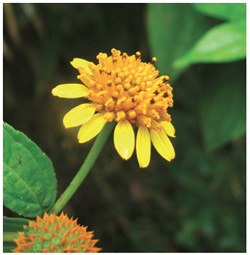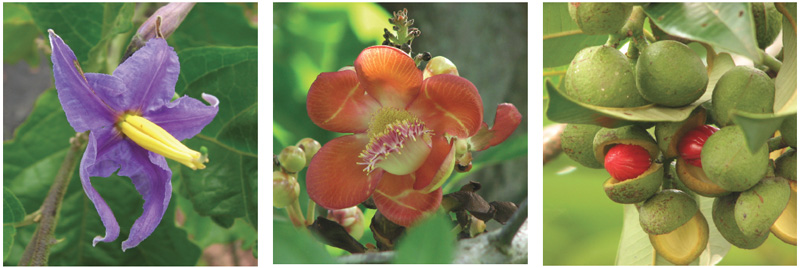
The National Herbarium of Trinidad and Tobago will formally launch its 200th anniversary celebrations on 22 May 2018 with a tree-planting ceremony at the St. Augustine Campus where the collection is housed under the stewardship of curator, Yasmin Baksh-Comeau.Among the activities planned is the collaboration with a re-afforestation project to take place in the hillside of Tunapuna, where 200 trees will be put to earth between Hillview College, the Biodiversity Society at The UWI and the Herbarium.The trees will form part of the promotion of greening the urban landscaping as part of ‘our green heritage’ and to become a part of the Virtual Campus Arboretum on the website at http://sta.uwi.edu/herbarium/ as soon as it is launched. Look out for more on the celebratory activities in our next issue.
 Biological collections preserved as dried or wet plant or animal specimens stored in herbaria or museum cupboards, jars or display cabinets, represent a snapshot of a particular moment in time which can tell a story or solve a problem. These seemingly dead specimens, if well maintained, serve as a valuable ‘biological clock’ linking the past with the present and the future. Biological collections preserved as dried or wet plant or animal specimens stored in herbaria or museum cupboards, jars or display cabinets, represent a snapshot of a particular moment in time which can tell a story or solve a problem. These seemingly dead specimens, if well maintained, serve as a valuable ‘biological clock’ linking the past with the present and the future.
Trinidad and Tobago has a long recorded history of plant exploration dating from 1498. Over the centuries countless specimens from Trinidad and Tobago have been removed and deposited in major herbaria in Europe and North America. It is this historical propensity for collecting and documenting specimens that gave rise to the National Herbarium of Trinidad and Tobago which originated with the Royal Botanic Gardens, Port of Spain established in 1818.
J. H. Hart, fourth Superintendent of the Botanic Gardens, formalised the herbarium in 1887 by salvaging some of the specimens from his predecessors. The earliest specimens rescued from these early collectors dating from 1842 are integrated with the extant collection.
The vascular flora of Trinidad and Tobago dominates the collections with a smaller regional sample. There are good representative samples of marine algae, mosses and liverworts.
The Herbarium provides a plant identification and information service. Identifying over 6,800 specimens for the public over the last 16 years involves challenges, such as, identification of seeds on a victim’s clothing or endorsing marijuana plants (Cannabis sativa) seized by the police.
A medical practitioner having a sick child ingesting unfamiliar seeds and subsequently identified as rubber seeds (Hevea brasiliensis) was treated for probably cyanide poisoning, and checking a packet of finely powdered “Cat’s Claw” from The Food & Drug Division of the Ministry of Health are examples of the work of the herbarium. Scholars world-wide, in any field involving plants, must seek out a herbarium. Similarly, two local publications come to mind Medicinal Plants of Trinidad and Tobago (Seaforth et al. 1982) and Dictionary of the English/Creole of Trinidad and Tobago (Winer 2009) relied heavily on our herbarium.
Recent research involved a botanical inventory undertaken from 2005-2008 to develop a Biodiversity Monitoring System for Trinidad and Tobago, in collaboration with Oxford University, UK and the Forestry Division, under the Darwin Initiative (this was done concurrently with refurbishment of the Herbarium). This botanical survey produced over 22,000 specimens of which 90% were identified using the reference collection. The results of this comprehensive study, soon to be published, have (i) identified biodiversity ‘hot spot’ areas, (ii) assessed the status of rare, threatened and endemic species, and (iii) form the basis for a new vegetation classification for Trinidad and Tobago.
In 2009, we initiated a student internship programme with the University of the Southern Caribbean in Maracas, Trinidad. This programme is designed to give students an opportunity to volunteer their time while gaining experience working in the herbarium. Thirty-one students have participated in the programme mounting over 3,000 specimens from the huge backlog of specimens accumulated over the years. The impact on USC students’ learning has been twofold: increasing awareness of the richness of the local flora and leaving a legacy behind with their mounted specimens. A long standing partnership continues with The Trinidad and Tobago Field Naturalists’ Club whose membership is dedicated to the study of our natural history. Members have made good use of the herbarium to identify plants from their field trips and have added valuable specimens to the collection.
More importantly, our herbarium is supported as ‘a national asset’ by the Government of Trinidad and Tobago.

Yasmin S. Baksh-Comeau is curator of the National Herbarium of Trinidad and Tobago, which is located at The UWI St. Augustine. |





